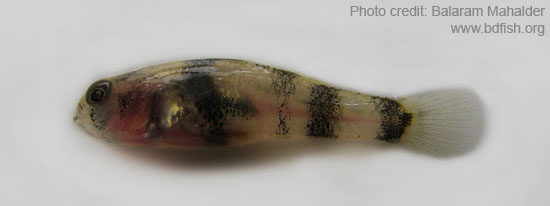
Systematic position
Phylum: Chordata
Class: Actinopterygii (Ray-finned fishes)
Order: Perciformes (Perches)
Suborder: Gobioidei
Family: Gobiidae (Gobies)
Subfamily: Gobionellinae
Genus: Brachygobius
Species: B. nunus
Synonyms
Gobius alcockii Annandale, 1906
Gobius bombayensis Annandale, 1919
Gobius nunus Hamilton, 1822
Common/local names
English: Bumblebee goby and Golden-banded goby
Bangladesh: Nuna baila (নুনা বাইলা)
Distributions: India, Burma, Thailand, Malaya, Sumatra, Java and Borneo (Talwar and Jhingran, 1991); Hoogly, Burma, Moulmein (Day, 1958).
Conservation status: Not threatened in Bangladesh (IUCN Bangladesh, 2000).
Morphology: Body posteriorly compressed, anteriorly cylindrical and small in size. Obtuse, convex and slightly depressed head present. Mouth oblique and upper jaw is shorter than lower jaw. Maxilla extends below the anterior third of the eye. Teeth in jaws present in jaws and are villiform. Outer raw of upper jaw is enlarged. Rounded tounge present. Second dorsal and anal are opposite each other and anal of about the same length. Dorsal fin lower than the height of the body. Rounded caudal fin present. Opercle scaled, 25-27 ctenoid scales in median late4ral series. Seven rows present between anal origin and base of second dorsal.
Head 3.2 in standard and 4.0 in total length. Height 3.2 in standard, 4.2 in total length. Eye 3.3; snout 0.6; interorbital 1.0 (Rahman, 1989 and 2005).
Body yellowish brown with 7 or 8 bands and first through the eye, second through the opercle and others more down the body. The last band present at the caudal base.
Fin formula:
D1. V; D2. 1/7; P1. 14-16; P2.6; A. 1/7; C. 15 (Rahman, 1989 and 2005)
D VI=I 7-8; A I 7-8; P i 13-15 (Talwar and Jhingran, 1991)
Maximum lengths: 1.7 cm TL (Rahman, 1989 and 2005) and 2.5 cm SL (Talwar and Jhingran, 1991).
Habitats: Inhabits estuaries, mangroves, tidal creeks and freshwaters (Talwar and Jhingran, 1991); Estuaries,mangroves tidal creeks and freshwater rivers (Rahman, 2005); Rivers, freshwater stream (Day, 1958); It inhabits brackish water swamp (Siddiqui et al., 2007). This species were distributed in the river Kangsha near Netrokona town and river Dakatia and Meghna near Chandpur (Rahman, 1989).
Food and feeding: It takes of all kinds of live food (Gunther Sterba, 1989)
Spawning: When abundantly fed on a varied diet and given changes of freshwater the fishes will spawn, preferably under stone or inside flowerpots. The eggs are large and number about 100-150 at spawning. The young hatch often about 4-5 days, often even earlier and guarded by the male (Gunther Sterba, 1989)
Fishery info: Of no interest to fisheries (Talwar and Jhingran, 1991) but reared and bred in aquaria in many countries.
__________________________________________________________
REFERENCES
Annandale N (1919) The fauna of certain small streams in the Bombay Presidency. v. Notes on freshwater fish mostly from the Satara and Poona districts. Records of the Indian Museum (Calcutta) 16(1): 125-138, Pl. 1.
Annandale N (1906) Notes on the freshwater fauna of India. No. VII. A new goby from fresh and brackish water in Lower Bengal. Journal and Proceedings of the Asiatic Society of Bengal 2(5): 201-202.
Day F (1958) The Fishes of India: being a Natural History of the fishes known to inhabit the seas and freshwater of India., Burma and Ceylon. Reproduced in 1958 by William Dowson and Sons, London, p. 297.
Hamilton F (1822) An account of the fishes found in the river Ganges and its branches. Edinburgh & London. An account of the fishes found in the river Ganges and its branches.: i-vii + 1-405, Pls. 1-39.
IUCN Bangladesh (2000) Red book of threatened fishes of Bangladesh, IUCN- The world conservation union. xii+116 pp.
Rahman AKA (1989) Freshwater Fishes of Bangladesh, 1st edition, Zoological Society of Bangladesh, Department of Zoology, University of Dhaka, Dhaka-1000, pp. 306-307.
Rahman AKA (2005) Freshwater Fishes of Bangladesh, 2nd edition, Zoological Society of Bangladesh, Department of Zoology, University of Dhaka, Dhaka-1000, pp. 332-333.
Siddiqui KU, Islam MA, Kabir SMH, Ahmad ATA, Rahman AKA, Haque EU, Ahmed ZU, Begum ZNT, Hasan MA, Khondker M and Rahman MM (eds) (2007) Encyclopedia of Flora and Fauna of Bangladesh, Vol. 23. Freshwter Fishes. Asiatic Society of Bangladesh, Dhaka, pp. 212-213.
Sterba G (1989) The Freshwater Fishes of the world. (Translated and revised by DW Tucker). London. Vol. 2. 763 pp.
Talwar PK and Jhingran AG (1991) Inland Fishes of India and Adjacent Countries, Vol. 2, Oxford & IBH Publishing Co. Pvt. Ltd. New Delhi-Calcutta, pp. 930-931.
Visited 1,492 times, 1 visits today | Have any fisheries relevant question?
